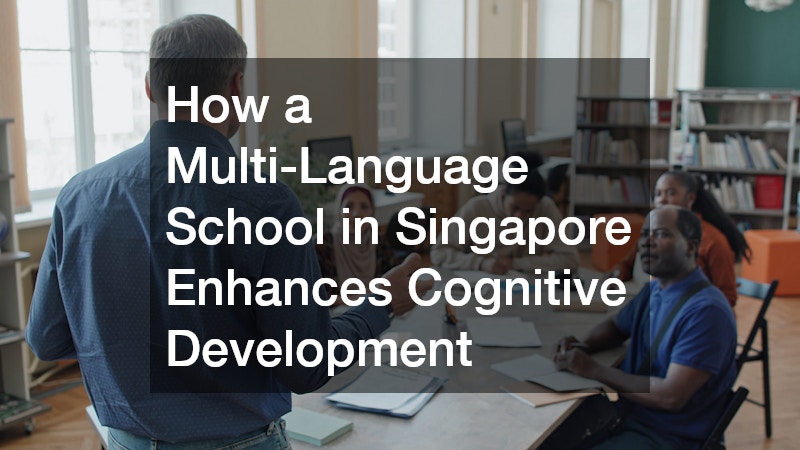In recent years, multi-language schools in Singapore have garnered increased attention as they offer unique educational benefits that extend beyond traditional learning. As the global community becomes more interconnected, the ability to communicate in multiple languages is increasingly recognized as a valuable skill. Multi-language schools provide students with an opportunity to immerse themselves in diverse linguistic environments, fostering not only language proficiency but also enhancing cognitive development. This exploration delves into the reasons behind the rising popularity of these institutions in Singapore and their profound impact on students’ cognitive abilities.
What is the role of a multi-language curriculum in cognitive development?
The role of a multi-language curriculum is pivotal in strengthening a child’s cognitive framework. Language learning, by its very nature, requires an engagement with memory, pattern recognition, and problem-solving abilities.
When children are exposed to a curriculum that incorporates multiple languages, they experience a dynamic shift in how they process and organize information. This complex cognitive activity significantly enhances areas such as memory retention and attention span, proving that a multi-language curriculum serves as a robust foundation for cognitive growth.
How does learning multiple languages affect brain functions?
Learning multiple languages has a profound effect on brain functions, particularly in the areas associated with executive control, memory, and even structural changes within the brain. Neurological studies have shown that bilingualism and multilingualism can induce significant gray matter growth, particularly in the language centers of the brain, such as the left hemisphere which is traditionally associated with logic and analytical thinking. This growth translates into enhanced cognitive capabilities, making the brain more efficient in processing information.
Are there social advantages gained from a multi-language school environment?
Beyond cognitive and academic benefits, multi-language schools offer significant social advantages that contribute to the holistic development of students. In today’s interconnected world, effective communication across sociocultural boundaries is vital, and proficiency in multiple languages enhances a student’s ability to interact with diverse communities. Multi-language education fosters empathy and cultural sensitivity, equipping students to become global citizens who appreciate and value cultural differences.
Students in multi-language schools gain access to a wider range of cultural resources, including literature, history, and current events from various parts of the world. By engaging with this rich tapestry of cultural narratives, students develop a nuanced understanding of global issues, which enhances their social awareness and critical thinking skills. This culturally enriched educational framework allows students to navigate multiple social contexts effectively, building bridges across cultural divides.
What challenges do students face in a multi-language school, and how are they overcome?
While the benefits of multi-language education are significant, students may encounter unique challenges as they navigate a curriculum that requires the mastery of several languages. A common difficulty is language interference, where similarities and differences between languages may cause confusion in grammar, vocabulary, or pronunciation. However, educators in multi-language schools are adept at identifying these challenges and employ teaching strategies that emphasize language distinction and application contexts, helping students to clearly demarcate linguistic boundaries.
Another challenge frequently faced by students is the cognitive load imposed by simultaneous language acquisition. Students are tasked with the intense mental challenge of assimilating new languages, which can affect initial academic performance and confidence. Educators and pedagogical approaches designed to scaffold language learning support students in managing this load, incorporating techniques such as differentiated instruction, peer collaboration, and immersive language experiences that make language acquisition more intuitive and less arduous.
How can parents support their children’s multi-language education?
Parental involvement is vital in supporting a child’s success in a multi-language educational context. Encouragement and active participation in language learning activities at home can create an enriching environment that sustains language acquisition. Parents can engage with their children through reading, storytelling, and communication in multiple languages, fostering an appreciation for linguistic diversity and enhancing linguistic skills.
Furthermore, parents can facilitate their children’s language learning by providing access to multimedia resources and language learning tools outside the classroom. Educational apps, language games, and exposure to foreign films can serve as additional avenues for practicing and reinforcing language skills. By integrating language learning into daily routines and leisure activities, parents can make language learning a fun and rewarding experience for their children, supporting their ongoing cognitive development.
Every multi-language school in Singapore represent a pioneering approach to education that not only equips students with linguistic fluency but also enhances cognitive development. By embracing a curriculum that integrates multiple languages, these schools provide students with tools that improve memory, executive functions, and social awareness. Despite the challenges that arise, the robust support systems within these educational settings ensure that students can effectively navigate and overcome them. Furthermore, the role of parents in supporting and complementing the multi-language education experience further enriches the student’s journey. Collectively, these elements illustrate the profound contribution of multi-language schools to cognitive and personal growth, preparing students for a world that values multi-lingual, culturally adept individuals.

